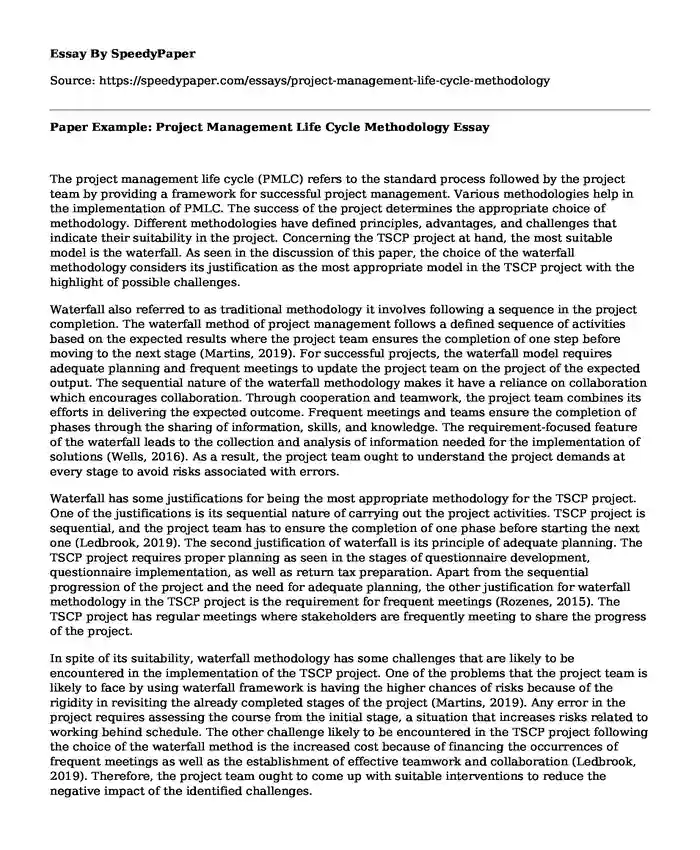
| Type of paper: | Essay |
| Categories: | Project management Strategic management Business strategy |
| Pages: | 3 |
| Wordcount: | 743 words |
The project management life cycle (PMLC) refers to the standard process followed by the project team by providing a framework for successful project management. Various methodologies help in the implementation of PMLC. The success of the project determines the appropriate choice of methodology. Different methodologies have defined principles, advantages, and challenges that indicate their suitability in the project. Concerning the TSCP project at hand, the most suitable model is the waterfall. As seen in the discussion of this paper, the choice of the waterfall methodology considers its justification as the most appropriate model in the TSCP project with the highlight of possible challenges.
Waterfall also referred to as traditional methodology it involves following a sequence in the project completion. The waterfall method of project management follows a defined sequence of activities based on the expected results where the project team ensures the completion of one step before moving to the next stage (Martins, 2019). For successful projects, the waterfall model requires adequate planning and frequent meetings to update the project team on the project of the expected output. The sequential nature of the waterfall methodology makes it have a reliance on collaboration which encourages collaboration. Through cooperation and teamwork, the project team combines its efforts in delivering the expected outcome. Frequent meetings and teams ensure the completion of phases through the sharing of information, skills, and knowledge. The requirement-focused feature of the waterfall leads to the collection and analysis of information needed for the implementation of solutions (Wells, 2016). As a result, the project team ought to understand the project demands at every stage to avoid risks associated with errors.
Waterfall has some justifications for being the most appropriate methodology for the TSCP project. One of the justifications is its sequential nature of carrying out the project activities. TSCP project is sequential, and the project team has to ensure the completion of one phase before starting the next one (Ledbrook, 2019). The second justification of waterfall is its principle of adequate planning. The TSCP project requires proper planning as seen in the stages of questionnaire development, questionnaire implementation, as well as return tax preparation. Apart from the sequential progression of the project and the need for adequate planning, the other justification for waterfall methodology in the TSCP project is the requirement for frequent meetings (Rozenes, 2015). The TSCP project has regular meetings where stakeholders are frequently meeting to share the progress of the project.
In spite of its suitability, waterfall methodology has some challenges that are likely to be encountered in the implementation of the TSCP project. One of the problems that the project team is likely to face by using waterfall framework is having the higher chances of risks because of the rigidity in revisiting the already completed stages of the project (Martins, 2019). Any error in the project requires assessing the course from the initial stage, a situation that increases risks related to working behind schedule. The other challenge likely to be encountered in the TSCP project following the choice of the waterfall method is the increased cost because of financing the occurrences of frequent meetings as well as the establishment of effective teamwork and collaboration (Ledbrook, 2019). Therefore, the project team ought to come up with suitable interventions to reduce the negative impact of the identified challenges.
Conclusively, the success of the project relies on the appropriate choice of methodology. The waterfall methodology is appropriate for TSCP project, and it follows a defined series of activities based on the expected results. The methodology also works with the requirement of frequent meetings and active collaboration of the team members. As a result, the waterfall method has justifications for being the most appropriate methodology for the TSCP project because of its step-wise requirement, frequent meetings, and effective teamwork. In spite of the waterfall's suitability, the methodology has challenges that are likely to be encountered in the implementation of the TSCP project; therefore, the project team ought to establish strategies to deal with the identified challenges.
References
Ledbrook, L. (2019). Waterfall Project Management: An Overview. Retrieved from http://projectcommunityonline.com/waterfall-project-management-an-overview.html
Martins, K. (2019). What the Waterfall Project Management Methodology Can (and Can't) Do for You. Retrieved from https://www.lucidchart.com/blog/waterfall-project-management-methodology
Rozenes, S. (2015). The Impact of Project Management Methodologies on Project Performance. International Journal Of Information Technology Project Management, 2(2), 64-73. doi: 10.4018/jitpm.2011040105
Wells, H. (2016). How Effective Are Project Management Methodologies? An Explorative Evaluation of Their Benefits in Practice. Project Management Journal, 43(6), 43-58. doi: 10.1002/pmj.21302
Cite this page
Paper Example: Project Management Life Cycle Methodology. (2022, Dec 20). Retrieved from https://speedypaper.com/essays/project-management-life-cycle-methodology
Request Removal
If you are the original author of this essay and no longer wish to have it published on the SpeedyPaper website, please click below to request its removal:
- Effective Finalization of Traffic Law, Free Essay Sample
- Police Work with Juveniles, Essay Sample at No Charge
- Free Essay: My Response to Antony on a Therapeutic Recreation Program Plan
- Essay Sample Dedicated to the Quality Initiatives in US Healthcare
- Essay Example about French Food in Thailand
- Free Essay on Developing an Infant-Toddler Curriculum
- Essay Example on Women on Boards: Does Diversity Guarantee Better Performance?
Popular categories




